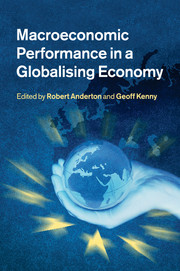Book contents
- Frontmatter
- Contents
- List of figures
- List of tables
- Notes on contributors
- Foreword by Jürgen Stark
- Acknowledgements
- 1 Globalisation and macroeconomic performance
- 2 The impact of globalisation on the euro area macroeconomy
- 3 Trade and foreign direct investment in business services: a modelling approach
- 4 Entry dynamics and the decline in exchange-rate pass-through
- 5 Does the exchange rate belong in monetary policy rules? New answers from a DSGE model with endogenous tradability and trade frictions
- 6 Globalisation and inflation in the OECD economies
- 7 Globalisation and euro area prices and labour markets: some evidence on the impact of low-cost countries
- 8 Monetary policy strategy in a global environment
- 9 Monetary policy in a global economy: past and future research challenges
- Index
- References
6 - Globalisation and inflation in the OECD economies
Published online by Cambridge University Press: 04 February 2011
- Frontmatter
- Contents
- List of figures
- List of tables
- Notes on contributors
- Foreword by Jürgen Stark
- Acknowledgements
- 1 Globalisation and macroeconomic performance
- 2 The impact of globalisation on the euro area macroeconomy
- 3 Trade and foreign direct investment in business services: a modelling approach
- 4 Entry dynamics and the decline in exchange-rate pass-through
- 5 Does the exchange rate belong in monetary policy rules? New answers from a DSGE model with endogenous tradability and trade frictions
- 6 Globalisation and inflation in the OECD economies
- 7 Globalisation and euro area prices and labour markets: some evidence on the impact of low-cost countries
- 8 Monetary policy strategy in a global environment
- 9 Monetary policy in a global economy: past and future research challenges
- Index
- References
Summary
Introduction
Over the past twenty-five years consumer price inflation has moderated considerably in all OECD economies, and also worldwide. The decline in OECD inflation from above 10 per cent in the early 1980s to around 2 per cent over the decade from 1995–2005 has been accompanied by a reduction in the variability of inflation and cross-country dispersion. These developments have coincided with a marked increase in the extent of globalisation, with the production of many goods and services becoming increasingly internationalised and the level of trade in goods and services between the OECD and non-OECD economies rising as a share of OECD GDP.
Ultimately, inflation should be determined by monetary policy. But many other factors can influence inflation, and in the short to medium term it can be difficult to assess whether any observed moderation in inflation results from monetary policy, structural factors such as globalisation or just good fortune. Globalisation itself, as reflected in trade and FDI, potentially affects inflation through a variety of channels (IMF, 2006a; Kohn, 2006). Enhanced trade integration with lower-cost economies may help to hold down domestic inflation by depressing trade prices and increasing the share of imports in domestic demand. Related to this, enhanced product market competition may have reduced the mark-ups of domestic producers. These forces and the internationalisation of production may also have helped to raise the cyclical influence of global capacity utilisation on domestic price inflation (Borio and Filardo, 2007).
- Type
- Chapter
- Information
- Macroeconomic Performance in a Globalising Economy , pp. 155 - 197Publisher: Cambridge University PressPrint publication year: 2010

